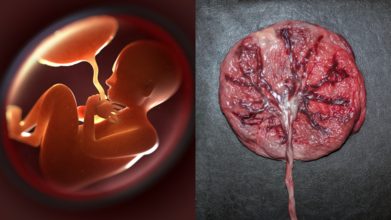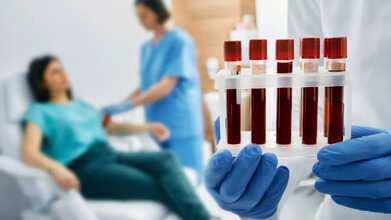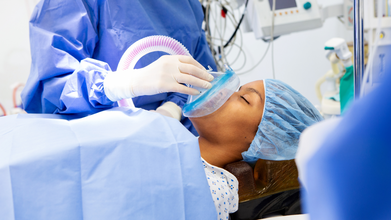- Health Conditions A-Z
- Health & Wellness
- Nutrition
- Fitness
- Health News
- Ayurveda
- Videos
- Medicine A-Z
- Parenting
- Web Stories
Why Placenta Banking Is Being Called the Ultimate Health Insurance for Families

Credits: Canva
If you thought the only souvenirs from childbirth were baby pictures and tiny socks, times have changed. Turns out, the real treasure might be something most parents never even glance at before it is thrown away: the placenta and umbilical cord. Doctors are now calling placenta banking “biological insurance”, and the idea is picking up pace.
Your Baby’s Placenta Is More Than Just Leftovers
For centuries, the placenta has been treated as medical waste. But according to Dr. D.B. Usha Rajinikanthan, Senior Consultant in Gynaecology and IVF at SIMS Hospital, Chennai, this organ is brimming with stem cells that could be life-saving later on.
“Placenta and cord blood contain stem cells that can repair or replace damaged tissue. Collecting them at birth is safe and painless, but once discarded, that opportunity is lost forever,” she says.
These tiny cells are essentially the body’s master builders, with the potential to transform into different blood and immune cells. Which means what is usually thrown in a bin could actually hold a family’s medical safety net.
Why Stem Cells Are a Big Deal
Stem cells from the placenta are not just versatile; they are generous. Dr. Rajinikanthan explains that they have already been used to treat more than 80 diseases worldwide, including leukaemia, certain immune deficiencies and metabolic disorders. “Research is expanding into conditions like heart repair, brain injury and even diabetes,” she adds.
Placental stem cells are “younger” and more flexible, making them easier to match with siblings and relatives. In simple terms, the baby, siblings, parents and even grandparents may stand to benefit. It is not just your child’s resource; it is potentially a family heirloom.
Placenta Preservation: A Health Insurance
If we insure our cars and houses against accidents, why not our health? Placenta banking works on that philosophy. “It is a one-time investment in future health security. Families may never need it, but having stored stem cells gives enormous peace of mind,” says Dr. Rajinikanthan. She emphasises, though, that choosing an accredited stem cell bank that follows quality standards is essential.
How Does Amniotic Membrane Help?
Beyond the cord blood, there is another underrated star, the amniotic membrane. Dr. A. Jaishree Gajaraj, Head of Obstetrics and Gynaecology at MGM Healthcare, Chennai, explains that the amnion has been saving lives for over a century. “The first use dates back to 1910 when it was applied as a skin graft to promote healing. Today, it is used in ophthalmology for dry eyes, as well as for burns and diabetic ulcers,” she says.
In other words, this part of the placenta is not just a wrapper for your baby; it is a medical toolkit waiting to be tapped.
The Science Behind the Promise
Stem cell science has moved leaps and bounds in recent decades. According to Dr. Gajaraj, the umbilical cord blood and tissue have already been used successfully in bone marrow transplants for children with leukaemia and other bone marrow disorders. But the real buzz is around their future potential.
“These pluripotent cells are being researched for regenerating organs like the pancreas, liver, lungs and even the spinal cord. While still experimental, the promise is extraordinary,” she explains.
She adds that mesenchymal stem cells (MSCs), particularly those derived from cord tissue, are showing the greatest promise in regenerative therapies. “Foetal MSCs from cord tissue expand better, are less likely to trigger immune rejection, and have higher therapeutic potential than their maternal counterparts,” says Dr. Gajaraj. Simply put, storing placenta and cord tissue maximises the number and types of cells available for future therapies.
But What About Delayed Cord Clamping?
Some parents worry that opting for placenta banking might compromise delayed cord clamping, the practice of waiting a few minutes before cutting the cord to allow extra blood flow to the baby. Dr. Gajaraj reassures that this is not the case. “Delayed clamping does not reduce the yield of mesenchymal stem cells. Parents can safely choose both practices,” she says.
A Gift From Your Newborn to the Whole Family
Placenta banking is not a crystal ball or a cure-all. It does not guarantee immunity against every illness. But as both doctors point out, it offers a shot at future treatments that could transform outcomes in life-threatening conditions
Long COVID Symptoms In Young Women May Trigger THIS Chronic Illness

Credits: Canva
When most people think of COVID today, they imagine a mild illness, like a cold, a few days of fever, a sore throat, or a cough, before recovery. But for many, the story does not end there. Long COVID, which the World Health Organization defines as symptoms lasting at least three months after infection, has become a lasting reality of the pandemic.
Most studies have focused on describing symptoms such as fatigue, brain fog, and shortness of breath. However, a recent study has shown that long COVID, especially in women, can trigger a chronic condition known as Postural Orthostatic Tachycardia Syndrome (POTS).
What Is Long Covid?
Long COVID affects roughly 6% of people who had COVID, with over 200 symptoms recorded. For some, it lasts just a few months, while for “long haulers,” it can continue for years. Measuring the scale of the problem is difficult because symptoms differ widely from person to person. This has sparked debates over what long COVID truly is, what causes it, and even whether it is real.
However, as per Johns Hopkins Medicine, common symptoms include fatigue, brain fog, shortness of breath, headaches, and changes in smell or taste, and multiple organ systems can be affected.
New Study Says Long Covid Can Trigger This One Chronic Illness
A study from Sweden found that young women with symptomatic long COVID were at a higher risk of developing POTS, adding an extra burden, according to research from the University of Nebraska Medical Center. Among a cohort of predominantly younger women with highly symptomatic post-COVID-19 sequelae (PCS), also called long COVID, there was a notable incidence of POTS. The research noted significantly lower physical activity and capacity in long COVID patients with POTS compared to those without it.
The study examined 467 non-hospitalized, highly symptomatic long COVID patients, 91% of whom were healthy, physically active women before their COVID infection. About 12 months after their initial COVID illness, patients underwent cardiologist evaluations including a 48-hour electrocardiogram, head-up tilt test, and Active Stand Test for those suspected of having POTS.
What Is Postural Orthostatic Tachycardia Syndrome (POTS)?
POTS is a disorder of the autonomic nervous system in which the heart rate rises excessively when standing. This can lead to symptoms like lightheadedness, fatigue, and fainting. In POTS, blood vessels don’t constrict as they should, causing blood to pool in the lower body and reducing blood flow to the brain. The nervous system compensates by releasing hormones that sharply increase heart rate, producing various symptoms, according to Johns Hopkins Medicine.
COVID-19 and POTS: Is There A Link?
POTS can be triggered by various factors, including viral or bacterial infections. Researchers believe the coronavirus that causes COVID-19 may act as a trigger, as more people recovering from COVID are showing POTS-like symptoms such as brain fog, rapid heartbeat (tachycardia), and severe chronic fatigue. The overlap in symptoms has prompted doctors to start testing patients for POTS.
Johns Hopkins explains that the autonomic nervous system controls functions we don’t consciously think about, like heart rate, blood pressure, sweating, and body temperature. Problems in these areas can cause symptoms that overlap with other conditions. Patients may have their POTS symptoms dismissed as lingering COVID effects or even psychological issues. Accurate diagnosis is critical, as POTS can be debilitating and requires targeted treatment.
How Can Volume Expansion Therapy Help With POTS?
The main goal of initial POTS treatment is to improve blood flow back to the heart, a strategy known as volume expansion therapy. This can include medication-based and non-medication approaches. Physical therapy also plays a key role in increasing blood volume over time. However, it often takes months before patients are able to respond enough to participate fully in physical therapy.
If you are experiencing COVID-like POTS symptoms, consult your healthcare professional for evaluation and guidance.
Health Tests To Do Before Diwali For A Safe And Stress-Free Festive Season

Credits: Canva
Diwali season is here, which brings with it the joy of celebrations, endless sweets, and festive food, all of which make this time of year so special. But to enjoy it fully without health worries, it is important to keep a check on your wellbeing with a few basic tests.
As the festivities begin, it is natural to get carried away with indulgent meals, late nights, and social gatherings. However, a few simple blood tests before Diwali can help you stay active, balanced, and ready to celebrate without any setbacks.
Why You Should Get Tested Before Diwali
Surrounded by all the happiness and excitement, many people tend to overlook their health during the festive season. This often leads to avoidable health issues that can interrupt the joy of celebrations and take away from the festive mood.
These problems usually stem from a few common habits that creep in during festivals, overeating, irregular sleep schedules, eating too many fried or sugary foods, skipping workouts, or changing usual meal times. They can also worsen any chronic health condition you already have.
You might now be wondering what these health problems are and whether they should be taken seriously. Mostly, they begin with stomach-related troubles that interfere with digestion, causing discomforts like acidity, gas, tiredness, constipation, diarrhoea, or irregular bowel movements. We got in touch with Dr Ranjeet Singh, Professor and HOD General Medicine- NIIMS Medical College And Hospital.
Do These Health Tests Before Diwali For A Festive Free Season
HbA1c and Blood Sugar Test
People living with diabetes should check their sugar levels before the festive season. An HbA1c test shows your average blood sugar over the last three months and helps your doctor adjust your diet or medicines accordingly. Even if you don’t have diabetes, a simple fasting or random blood sugar test can help you track early signs of imbalance, especially if you plan to indulge in sweets and rich foods.
Blood Pressure Check
Irregular blood pressure is common during festivals due to stress, erratic sleep, and heavy food intake. Both high and low BP can cause headaches, dizziness, or even heart complications. Checking your blood pressure and basic heart health markers before Diwali ensures you celebrate safely without fatigue or uneasiness.
Liver Function Test (LFT)
Festive feasts are often loaded with fried, oily, and sugary items that can strain your liver. The Liver Function Test helps assess how well your liver is processing toxins and nutrients. If you already have liver concerns or a history of fatty liver, this test becomes even more essential before you begin your festive indulgence.
Kidney Function Test (KFT)
The Kidney Function Test checks how efficiently your kidneys are filtering waste and maintaining fluid balance. Overeating, dehydration, or excess salt and sweets can put pressure on your kidneys. Getting this test done before the festivities helps detect any early signs of kidney stress or damage.
Thyroid Function Test
Thyroid hormones control your metabolism, mood, and energy levels but when they get imbalanced, they can lead to fatigue, mood swings, or sudden weight changes, issues that tend to worsen during the festive rush. A Thyroid Function Test ensures your hormone levels are stable, helping you feel active and positive throughout the season.
Lipid Profile (Cholesterol Test)
During Diwali, fried snacks and sweets can cause a spike in cholesterol levels. A Lipid Profile Test helps measure good and bad cholesterol and triglycerides in your blood. If you get your Lipid profile done before Diwali, it can make you make better decisions when you are gorging on all the diwali sweets and make smarter food choices through the festive week.
To enjoy Diwali while reducing the risk of health problems, it’s a good idea to get these essential tests done in advance. Keeping your health in check will help you make the most of the celebrations without worry.
You can also encourage your family and friends to do the same. Remind them to take simple preventive steps and schedule their checkups so that everyone can enjoy a safe Diwali.
World Anesthesia Day 2025: What Do Our Minds Do Under Anesthesia?

Credits: Canva
It was 1846, when a young man lay on an operating table as doctors were ready to perform a surgery to remove a tumor from his neck. Then came a strange-smelling vapor. It was mix of ether and oil, and it filled the room. The man lying on the operation table did not flinch or cry out, there was no pain. When he woke up, it was as if nothing had happened.
This was the day that marked the dawn of general anesthesia. It was on this day today in 1846, that surgical anesthetic WTG Morton conducted the first successful demonstration of ether. Thus, this day is observed as the World Anesthesia Day.
Nearly two centuries later, scientists are still trying to figure out what actually happens to the brain when we under go anesthesia?
The Mind Under Anesthesia
Anesthesia doesn’t simply make a person “fall asleep.” It creates a state where the brain disconnects from conscious awareness while vital body functions remain stable.
When the drug enters your bloodstream, it alters how the nerve cells in the brain communicate. Usually, a billion of neurons send and receive signals rapidly, and forms networks responsible for thinking, feeling, and awareness. However, when anesthesia enters the body, these signals slow down or stop and it disrupts the communication between key regions, such as the cortex, which is responsible for handling thought and sensory perception, and the thalamus, which is responsible for processing information from the body.
Furthermore, the brainwave pattern, which usually looks fast and varied on an EEG, shift into slower and larger waves. The mind actually "tunes out" losing its ability to form memories, sense time, or even to process pain.
While anesthesia is designed to create total unconsciousness, it’s a delicate balance. Too little, and traces of awareness can slip through, a phenomenon known as accidental awareness, where patients recall sounds, sensations, or pressure during surgery. It’s rare but can be distressing.
However, too much can make the brain enter a state of extreme suppression. In such cases, EEG readings show almost flat patterns, indicating that neurons have gone quiet. This can also raise the risk of confusion or cognitive issues after surgery, especially among older adults.
In most people, the fog clears within hours, but some experience short-term problems with memory or focus, known as post-operative cognitive dysfunction. In older patients, this sometimes extends into delirium — temporary disorientation or hallucinations caused by lingering changes in brain activity.
How Does The Mind Wake Up?
You do not immediately wake up, but the mind reboots in layers. High-order functions like reasoning and self-awareness are the first to recover, then attention, coordination, and reaction time.
Studies show that as the anesthetic wears off, brain activity gradually reconnects across different regions. Certain rhythms that dominate during unconsciousness fade, replaced by faster, more complex patterns as the brain resumes its normal communication. It’s as though the mind is reassembling itself, piece by piece.
Anesthesia does not just turn the brain off, but reshapes consciousness, suspending awareness, while also preserving life.
© 2024 Bennett, Coleman & Company Limited

